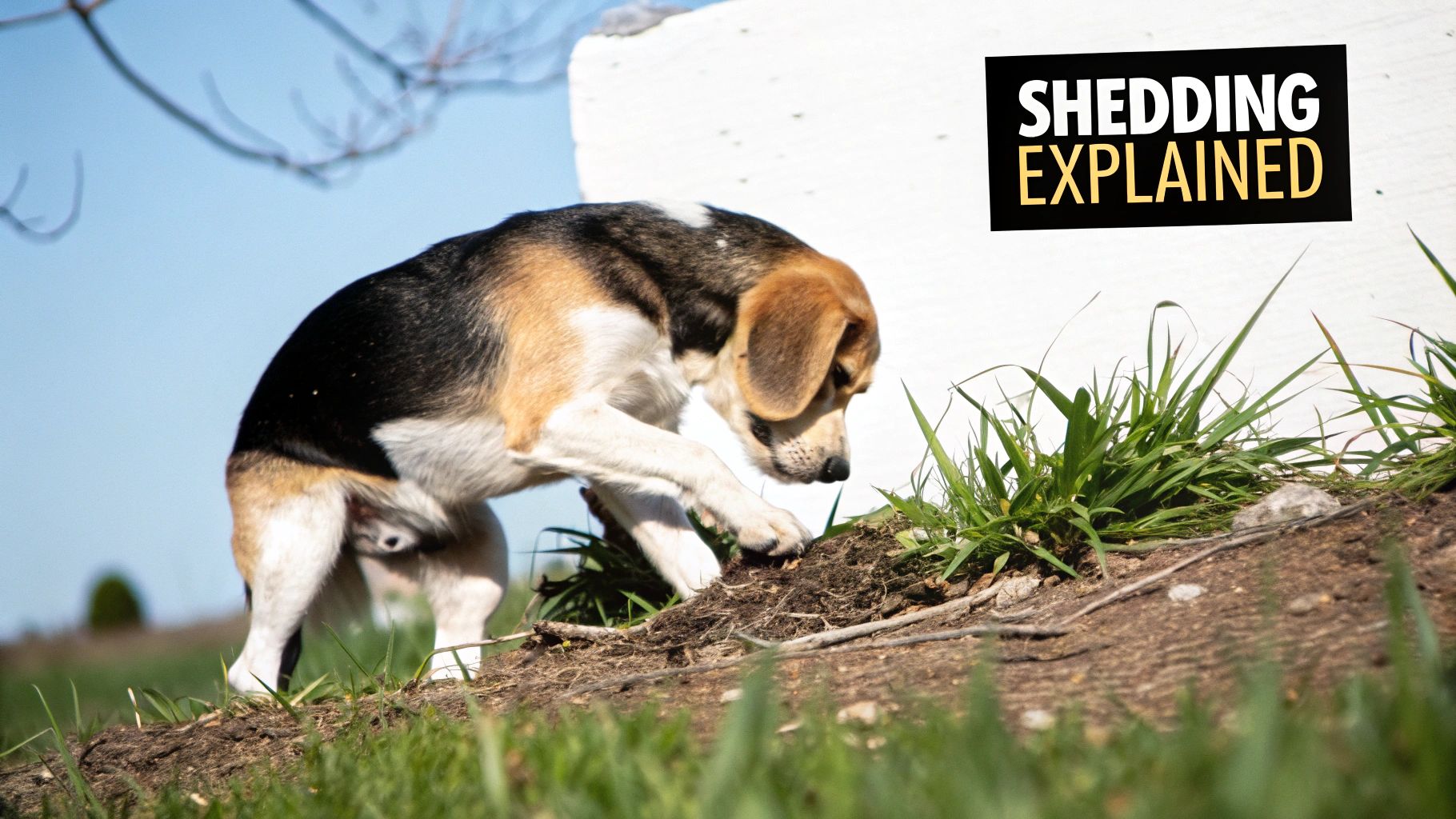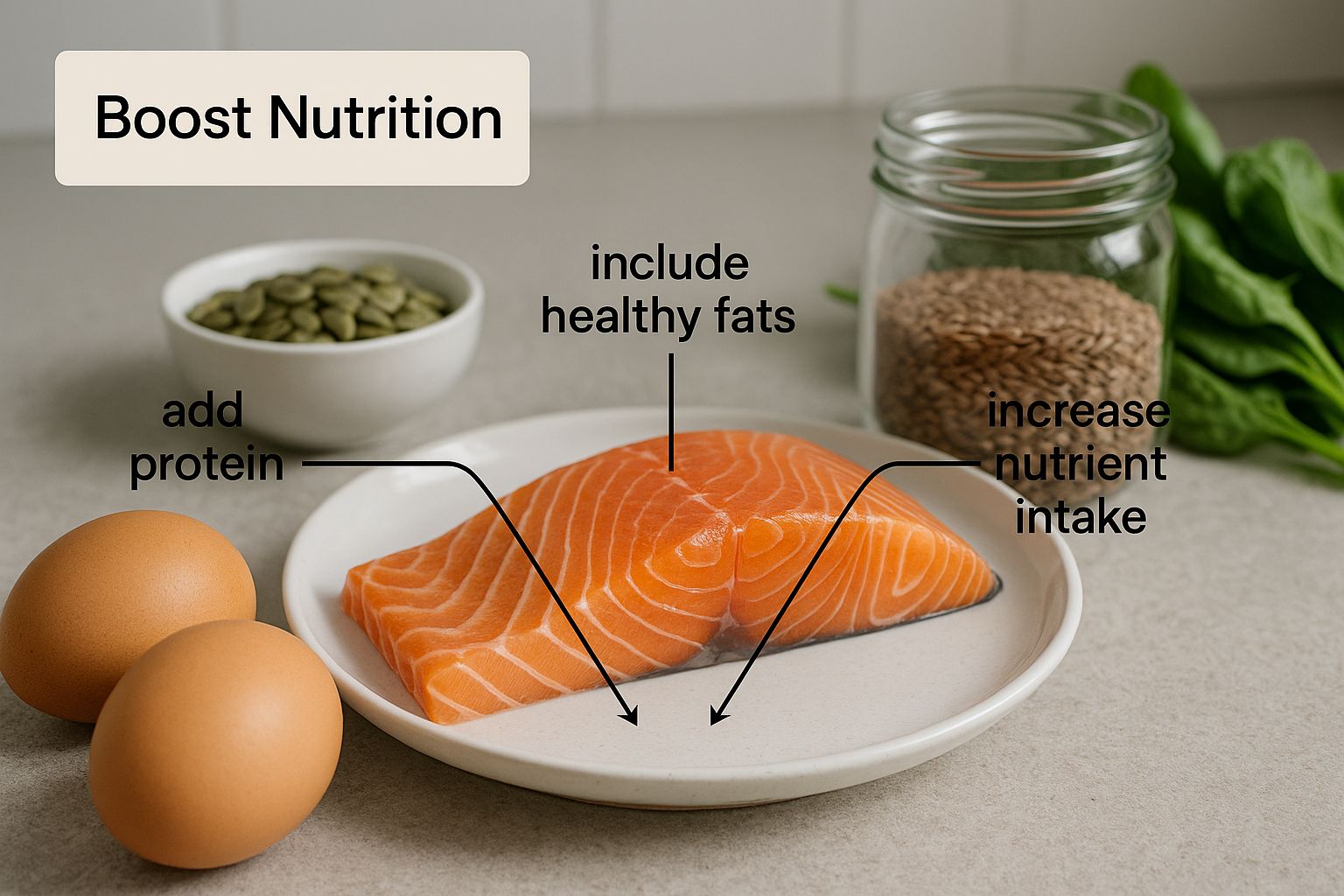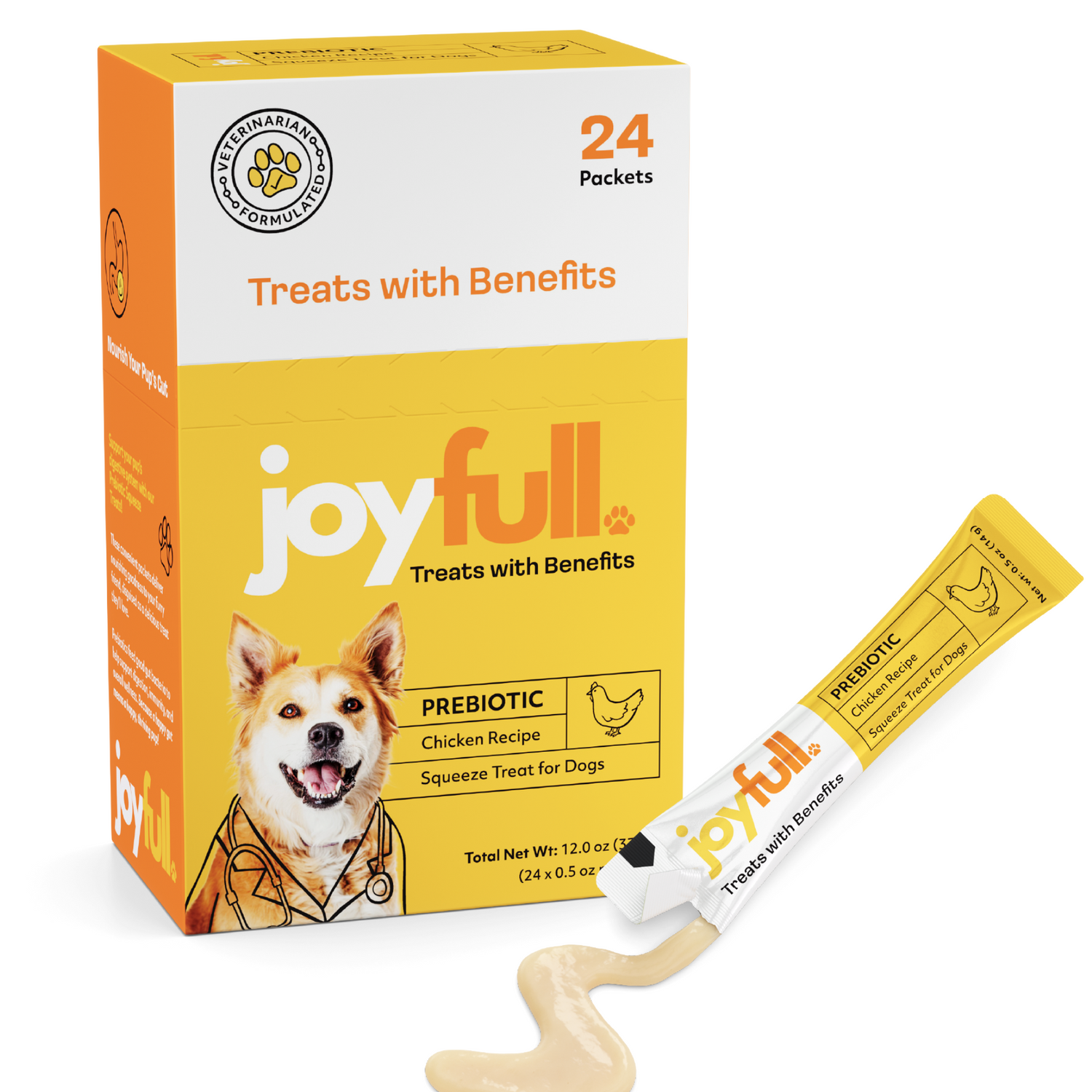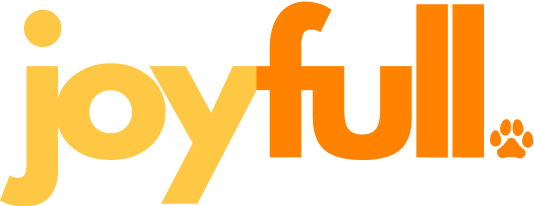
Dog Food Reduce Shedding: Top Tips for a Healthier Coat
Yes, the right dog food can absolutely help reduce shedding. It's all about providing the essential nutrients that strengthen hair follicles and improve skin health from the inside out. Think of choosing a diet rich in high-quality protein, omega fatty acids, and key minerals as your first—and most effective—line of defense against that constant cloud of fur.
Tired of Fur Everywhere? How Diet Tames Shedding
If you're constantly fighting a losing battle with dog hair on your clothes, furniture, and floors, you're definitely not alone. While a certain amount of shedding is completely normal for most dogs, when it becomes excessive, the problem often starts right in their food bowl.
Your dog's diet is the foundation for their entire well-being, and their coat is one of the clearest signs of what’s going on internally. Feeding a subpar diet is like trying to build a house with flimsy materials; eventually, things start to fall apart—or in this case, fall out.
This guide will walk you through how the right nutrition can be your best tool for managing shedding. We'll look at the direct link between what your dog eats and the health of their coat, showing you exactly which ingredients can fortify every single strand of hair.
The Power in Their Bowl
The good news is that you don't need a miracle cure. Making a few strategic changes to what's in their bowl can dramatically cut down on shedding, leaving you with a healthier, happier dog and a much cleaner home. The secret is knowing which nutrients are non-negotiable for a strong, resilient coat.
- High-Quality Protein: Did you know hair is about 95% protein? Supplying easily digestible sources like chicken, beef, or fish gives your dog the fundamental building blocks they need for strong, healthy hair.
- Essential Fatty Acids: Omega-3 and omega-6 fatty acids are like an internal moisturizer for your dog. They hydrate the skin and reduce the kind of inflammation that often leads to shedding and hair loss.
- Vitamins and Minerals: Key players like zinc and vitamin E are crucial for supporting healthy hair follicles and the production of new skin cells, keeping the coat's foundation strong.
A shiny, soft coat is often the very first sign of excellent nutrition. On the flip side, a poor-quality diet almost always leads to dry, brittle fur that breaks and falls out easily, turning normal shedding into a constant headache.
By focusing on these core nutritional pillars, you can shift from constantly cleaning up fur to simply enjoying your healthy, less-shedding companion. It’s all about giving their body the fundamental support it needs to thrive.
Quick Guide to Coat-Boosting Nutrients
To make things a little easier, here's a quick reference table that breaks down the most important nutrients for a healthy coat and where to find them.
| Nutrient | How It Helps Reduce Shedding | Top Food Sources |
|---|---|---|
| High-Quality Protein | Provides keratin, the structural building block of hair, for stronger, more resilient strands. | Chicken, beef, lamb, fish (salmon, tuna), eggs. |
| Omega-3 Fatty Acids | Fights inflammation, hydrates skin, and adds a natural shine to the coat, reducing dryness and breakage. | Fish oil (salmon, sardine), flaxseed, chia seeds. |
| Omega-6 Fatty Acids | Maintains the skin's moisture barrier, preventing dryness and itchiness that can lead to excessive shedding. | Chicken fat, sunflower oil, corn oil. |
| Zinc | Essential for cell division and protein synthesis, which are critical for healthy skin and hair follicle function. | Red meat, poultry, fish, beans. |
| Biotin (Vitamin B7) | Supports the metabolism of fats and amino acids, which are vital for maintaining skin and coat health. | Liver, eggs, salmon, sweet potatoes. |
| Vitamin E | An antioxidant that protects skin cells from oxidative damage and supports a healthy immune system. | Spinach, broccoli, sunflower seeds, peanut butter. |
Remember, seeing these ingredients on a dog food label is a great sign that the formula is designed to support skin and coat health from the ground up.
Understanding Why Your Dog Sheds So Much

Before we can pick the right dog food to reduce shedding, we first have to understand why all that fur is flying in the first place. Shedding is completely normal. In fact, it’s a vital process that lets your dog ditch old, damaged hair to make room for a healthy new coat.
Think of it like a built-in renewal system. Each hair follicle on your dog has its own cycle of growing, resting, and eventually falling out. How much shedding happens depends on a lot of things, which explains why your Golden Retriever might leave fur tumbleweeds around the house while your neighbor's Poodle barely leaves a trace.
A little bit of shedding is one thing, but when it feels like you're living in a constant fur storm, it's easy to get overwhelmed. This is where it’s important to know the difference between a natural process and a sign that something might be off. Once you can spot the difference, you can take the right steps to manage it.
The Natural Shedding Cycle
A dog's hair doesn't just grow and grow forever. It follows a distinct cycle that keeps their coat in top shape and ready for whatever the environment throws at it. The main things driving this natural process are:
- Breed Genetics: Let’s face it, some breeds are just built to shed. Double-coated dogs like Huskies and German Shepherds are famous for "blowing" their thick winter undercoat every spring to get ready for the summer heat. It's just in their DNA.
- Seasons and Light Exposure: The changing length of daylight is a major cue for a dog's body. It triggers hormones that tell them when to shed a heavy coat for a lighter one, and then bulk back up for winter. Dogs who spend most of their time indoors under artificial light can sometimes shed more consistently all year long.
- Overall Health: A dog's coat is a fantastic window into their overall health. A shiny, strong coat usually means you have a healthy dog on your hands.
When Shedding Becomes a Red Flag
So, when does shedding cross the line from normal to worrisome? Big seasonal sheds are totally expected. But if the shedding seems relentless, or if it comes with other symptoms, it could point to an underlying issue. And very often, that issue starts in the food bowl.
Your dog's hair is made of about 95% protein. If their diet is missing high-quality, easy-to-digest protein or other key nutrients, their body simply doesn't have the building blocks to create strong hair. The result? A dull, brittle coat that sheds and breaks way too easily.
This is the critical link: poor nutrition can directly sabotage the health of your dog’s coat. You might also notice other red flags like bald patches, skin irritation, or fur that feels unusually dry and coarse. These are all signs that the shedding is more than just seasonal—and that a change in diet could be exactly what’s needed to get things back on track.
The Role of Omega Fatty Acids in Coat Health
If you're trying to get a handle on your dog's shedding, some of the most effective tools are already in their food bowl. I'm talking about healthy fats, specifically the superstars of skin and coat health: omega-3 and omega-6 fatty acids. These aren't just wellness buzzwords; they're essential nutrients that work like an internal moisturizer for your dog.
Think of it this way: your dog's skin is like the soil in a garden, and their fur is the plants growing from it. For those plants to be strong and vibrant, the soil has to be healthy and hydrated. Omega fatty acids do the same thing for your dog—they nourish the skin from within, which in turn supports strong, resilient hair follicles. This is the foundation of any good dog food to reduce shedding.
Omega-3 vs. Omega-6: What’s the Difference?
While both omega-3 and omega-6 are crucial, they have different, complementary jobs. Omega-6 fatty acids are fantastic for maintaining the skin's natural moisture barrier, which keeps it from getting dry, flaky, and itchy. Omega-3s, on the other hand, are famous for their anti-inflammatory power, helping to calm irritated skin that often leads to scratching and hair loss.
The key is getting the right balance. A lot of commercial dog foods have plenty of omega-6s (from common ingredients like chicken fat and corn oil) but fall short on the omega-3s. That's why you need to specifically look for foods that include quality sources of omega-3s.
This is where ingredients like salmon, fish oil, and certain seeds come into play, giving your dog that much-needed nutritional boost for a healthier coat.

As you can see, it's these fresh, whole-food ingredients that deliver essential fatty acids directly into your dog's diet.
Reading the Label for Coat Health
So, how do you spot these coat-saving ingredients on a dog food label? You’ll want to look for specific, high-quality sources listed clearly in the ingredients panel.
Here's what to keep an eye out for:
- Omega-3 Sources: Look for ingredients like salmon, fish oil (especially from salmon or sardines), flaxseed, and chia seeds. You might also see the abbreviations EPA (eicosapentaenoic acid) and DHA (docosahexaenoic acid), which are the potent, ready-to-use forms of omega-3s found in fish oil.
- Omega-6 Sources: Common sources include chicken fat, sunflower oil, and safflower oil.
Since dogs can't produce these essential fats on their own, they have to get them from their diet. Veterinarians often recommend diets rich in these fatty acids because they help reduce skin inflammation and improve hydration, which directly leads to less shedding. This is why salmon-based diets are so often recommended for dogs with skin and coat issues.
By making sure your dog gets a balanced ratio of these fatty acids, you aren't just crossing your fingers for a healthier coat—you're actively building one from the inside out. A diet rich in omegas gets right to the root cause of poor coat health.
It's interesting to note the parallels in hair care. Just as we look to natural oils for hair health for ourselves, the same principle applies to our dogs. It just reinforces how fundamental good fats are for maintaining strong, shiny hair, whether on a human or a canine.
How Quality Protein and Minerals Build a Stronger Coat

If omega fatty acids are the moisturizers for your dog's skin, then high-quality protein and minerals are the actual building materials for a strong, healthy coat. It's a surprising fact, but your dog's hair is made of roughly 95% protein. That number alone shows you that protein isn't just for building muscle—it’s the core component of every single strand of fur.
Think of it like building a brick wall. If you use cheap, crumbly bricks, the wall will be weak and fall apart easily. The same is true for your dog's coat. A diet loaded with hard-to-digest protein fillers from corn or mystery meat "by-products" is just like using those poor-quality bricks. The body can't use them to build strong hair, which results in a brittle coat that breaks and sheds all over your house.
This is exactly why the source of the protein in your dog's food matters so much. When you're looking for a dog food to reduce shedding, you want to see highly digestible, animal-based proteins at the top of the ingredient list.
The Power of Premium Protein Sources
Not all protein is created equal from your dog’s perspective. The best sources provide a full set of amino acids—the tools needed to build strong keratin, which is the specific type of protein that makes up hair.
Let's break down the difference:
- High-Quality Proteins: These come from clearly named meats like deboned chicken, beef, lamb, or fish. They are easy for your dog to absorb, meaning their body can put those amino acids to work right away, strengthening the skin and hair follicles.
- Low-Quality Fillers: Vague ingredients like "meat and bone meal" or plant proteins like corn gluten meal are much tougher for a dog's system to break down. This means fewer of the essential nutrients ever make it to where they're needed most: the skin and coat.
By choosing food with real, identifiable meat as the first ingredient, you're giving your dog the best possible raw materials for a fantastic coat. We dive deeper into this topic in our guide on high-quality protein for dogs.
Zinc: The Foreman of Follicle Health
Beyond protein, certain minerals act like supervisors on the construction site of your dog's coat. Zinc, in particular, is a workhorse. Think of it as the foreman, directing cell growth and making sure the hair follicles are built correctly and stay strong.
A zinc deficiency can quickly cause a dull, thinning coat and a frustrating amount of shedding because it throws the normal hair growth cycle out of whack. This mineral is also crucial for producing sebum, the natural oil that keeps both skin and hair moisturized, preventing the dryness that leads to breakage.
The bottom line? A powerful combination of premium protein and essential minerals like zinc creates the perfect internal environment for a strong, low-shedding coat. It’s a nutritional one-two punch that tackles hair health right at its foundation.
How to Choose the Right Anti-Shedding Dog Food
Walking down the pet food aisle can feel like a pop quiz you didn't study for. Every bag boasts the secret to a healthier, happier dog. When your mission is to find the best dog food to reduce shedding, the label is your cheat sheet—if you know how to read it. This is where you put all that nutritional know-how into action.
Forget the flashy pictures and marketing slogans on the front of the bag. The real story is always on the back. The ingredient list and the guaranteed analysis panel are where the truth is told, giving you the power to pick a food that genuinely builds a strong, brilliant coat from the inside out.
Decoding the Ingredient List
A dog food ingredient list is pretty straightforward: it’s organized by weight, with the heaviest stuff listed first. This means the first five ingredients are the main event, making up the vast majority of what’s in your dog's bowl. For a diet designed to tackle shedding, what’s in those top spots is absolutely critical.
Here’s what you want to see headlining the list:
- Whole, Named Protein Sources: Keep an eye out for ingredients like "deboned chicken," "lamb," "beef," or "salmon." These are the good guys—high-quality, easily digestible proteins packed with the amino acids needed to build tough hair follicles. Steer clear of vague terms like "meat by-products" or "poultry meal," which often signal lower-quality, less effective ingredients.
- Healthy Fats and Oils: Sources of those all-important omega fatty acids should be easy to spot. Ingredients like "salmon oil," "chicken fat," and "flaxseed" are fantastic signs that the formula is built to support skin and coat health.
Learning to spot these key players is a game-changer. If you want to dive even deeper, our complete guide on how to read dog food labels has even more pro tips.
Making Sense of the Guaranteed Analysis
Right next to the ingredient list, you’ll find a box labeled "Guaranteed Analysis." This tells you the minimum percentages of crude protein and fat, along with the maximums for fiber and moisture. While it won't tell you about the quality of the ingredients, it does confirm the nutritional breakdown.
Think of it this way: the ingredient list tells you what's in the food, and the guaranteed analysis tells you how much of it there is. A top-tier anti-shedding food will have both high-quality ingredients and the protein and fat percentages to back them up.
For an adult dog, you’ll want to see a minimum crude protein level of at least 18%. But honestly, most premium formulas designed for coat health will pack a bigger punch, often offering 25% or more. For crude fat, look for a percentage between 10-15% to ensure your dog is getting a solid dose of essential fatty acids.
Comparing Good vs. Bad Labels
Okay, let's put this into practice. Imagine you’re comparing two bags of food.
High-Quality Label (What to Look For):
- Deboned Salmon
- Chicken Meal
- Sweet Potatoes
- Peas
- Chicken Fat (preserved with mixed tocopherols)
This label hits all the right notes. It kicks off with two specific, high-quality protein sources and includes a healthy, naturally preserved fat. This is exactly the kind of foundation you want for a low-shedding diet.
Subpar Label (Red Flags to Avoid):
- Corn
- Meat and Bone Meal
- Soybean Meal
- Poultry By-Product Meal
- Animal Fat (preserved with BHA)
This one is a different story. It starts with a cheap filler (corn), uses vague, low-quality protein sources, and relies on a chemically preserved fat. It’s missing the targeted nutrition needed to strengthen your dog's coat and probably won’t do much to stop the shedding. Once you learn to spot these differences, you can navigate the pet food aisle like a pro and choose a food that will truly nourish your dog from skin to fur.
The Grain-Free Diet Debate and Your Dog's Shedding
Grain-free dog food is everywhere. It’s often sold as the premium choice for everything from digestive woes to a shiny coat. But if you’re trying to find a dog food to reduce shedding, is cutting out grains the silver bullet you’ve been hoping for?
Honestly, it’s not that straightforward.
For a small slice of the dog population, switching to a grain-free diet can be a game-changer. If your dog truly has an allergy or sensitivity to common grains like corn, wheat, or soy, these ingredients can absolutely cause skin inflammation. That irritation leads to constant scratching, which in turn causes more hair to fall out. For these specific dogs, yanking the problem grain from their diet can bring amazing relief, calming their skin and strengthening their coat.
But for most dogs, grains aren't the villain. The real secret to a healthy coat isn't about what you take out of their bowl, but what you put in.
Quality Over Absence
Getting fixated on the "grain-free" label can make you miss the bigger picture: the overall quality of the food. It's easy to find a grain-free formula that's loaded with cheap fillers and low-grade proteins that do absolutely nothing for your dog's skin.
A better strategy is to look for foods built around high-quality, named protein sources (like "chicken" or "salmon," not just "meat meal"), healthy omega fatty acids, and vital minerals. A kibble made with salmon, chicken, and flaxseed that also includes wholesome grains like brown rice will almost always do more for your dog’s coat than a grain-free food filled with potato starch and mystery meat.
To go deeper on this topic, check out our article on whether grain-free dog food is better.
The bottom line is this: Don't chase a trend; chase quality. A food’s power to curb shedding comes from nutrient-dense, high-quality ingredients—not from simply leaving out one food group.
The connection isn't always clear-cut. While some dogs with grain allergies definitely benefit, expert reviews show that the food's complete nutritional profile is what really matters. In fact, veterinary nutritionists estimate that only about 15-20% of shedding improvements are directly linked to removing grains from a dog's diet. You can find more on the connection between diet and coat health on Houndsy.com.
At the end of the day, the right choice depends entirely on your dog's individual needs, not on the latest marketing buzz.
Still Have Questions About Switching Foods?
Changing up your dog's diet is a big step, and it's totally normal to have a few questions before you dive in. Knowing what to expect in terms of timing and how to make the switch smoothly will set both you and your dog up for success.
How Long Before My Dog’s Shedding Actually Slows Down?
This is the big one, right? You'll need a little patience here. Think about how long it takes for your own hair to grow—it’s a process. It generally takes a good 6 to 8 weeks to see a real, noticeable difference in your dog's shedding after a food change.
That's because you're waiting for the new, healthier hair to grow in and push out the old, weaker fur. It’s a full growth cycle, but the results are well worth the wait.
What About Adding Supplements to Their Diet?
Supplements can definitely give your dog's coat an extra boost, but they're not a magic bullet. Think of them as a helper, not a replacement for a great diet.
Fish oil capsules, for instance, are packed with those coat-loving omega-3s and can be a fantastic addition. But it's always best to have a quick chat with your vet before starting any new supplement, just to make sure it’s the right move for your specific dog.
What’s the Best Way to Introduce a New Food?
Slow and steady wins the race here. A gradual transition over 7 to 10 days is the golden rule to avoid any tummy troubles like diarrhea or vomiting.
Start by mixing just a little of the new food in with the old—say, 25% new to 75% old. Every couple of days, increase the amount of new food until you've fully transitioned over. It's a simple process that makes a world of difference for their digestive system.
At Joyfull, we’re all about the idea that a healthy, beautiful coat is built from the inside out with clean, powerful ingredients. Our recipes are crafted to give your dog the exact nutrients they need to look and feel their best, with less shedding. See the difference for yourself.

